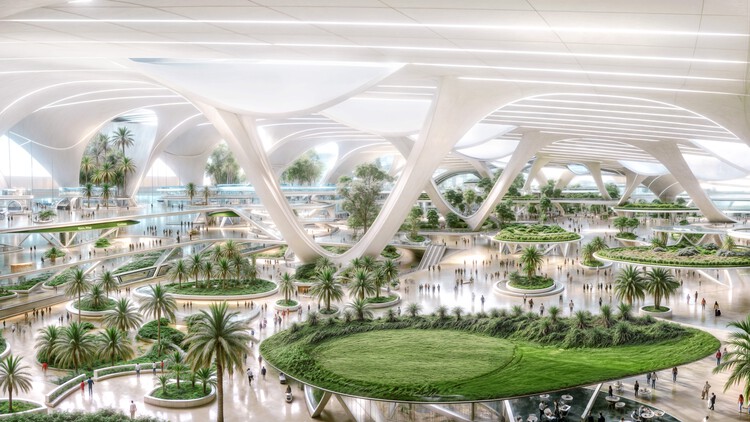
Coop Himmelb(l)au has been selected to lead the architectural design for the new Al Maktoum International Airport in Dubai, United Arab Emirates. Working in collaboration with Dubai Aviation Engineering Projects (DAEP) and Dar Al-Handasah, the design integrates advanced structural solutions, energy efficiency, and modern technologies to create a facility of global significance.

The airport’s design emphasizes expansive, open spaces aimed at providing a seamless experience for visitors. The roof serves both as a functional element and a prominent design feature, reflecting Dubai’s aspirations. The incorporation of technologies such as smart navigation and natural lighting is intended to enhance passenger comfort and streamline the travel process. Designed with artificial intelligence (AI) and advanced methodologies, the airport aims to offer a user-friendly experience. The layout is optimized to improve passenger flow and operational efficiency, from check-in to security.
Drawing inspiration from Dubai’s cultural heritage, the design blends traditional elements with contemporary materials and techniques, balancing respect for the past with a vision for the future. The airport is envisioned as a place where global travelers from diverse cultures can connect, promoting an inclusive and welcoming atmosphere.
Related Article
Shaping Space with Curves: Exploring the Architectural Fluidity of 4 Modern Airport Projects in South and East AsiaAdditionally, sustainability is a key focus of the airport’s design. Energy-efficient strategies, such as maximizing natural light through carefully placed windows and skylights, reduce the need for artificial lighting. Renewable energy sources are also integrated to minimize the airport’s environmental impact. Additionally, the design takes into account factors such as daylight analysis and prevailing winds to optimize the terminal’s orientation and shape. By leveraging these natural elements, the airport reduces its reliance on artificial energy, creating a more comfortable and energy-efficient environment.

COOP HIMMELB(L)AU’s approach also utilizes technologies like parametric design and algorithmic processes to optimize the geometry of the airport’s structures. This strategy is intended to enhance both the functionality and aesthetics of the buildings. The design emphasizes openness and connectivity, creating structures that are accessible and well-integrated with their surroundings, rather than enclosed or isolated.
In other similar news, Ethiopian Airlines Group has initiated a project to construct Africa's largest airport in Abusera, south of Addis Ababa, designed by Zaha Hadid Architects. Similarly, the City of Chicago has just unveiled the design for the first phase of the transformation of O’Hare International Airport designed by Skidmore, Ownings & Merrill (SOM). Additionally, MAD Architects has just unveiled the design for Lishui Airport in China. Dubbed the "forest city,” Lishui is known for its green landscapes and valleys in the Southwest Zhejiang Province.











